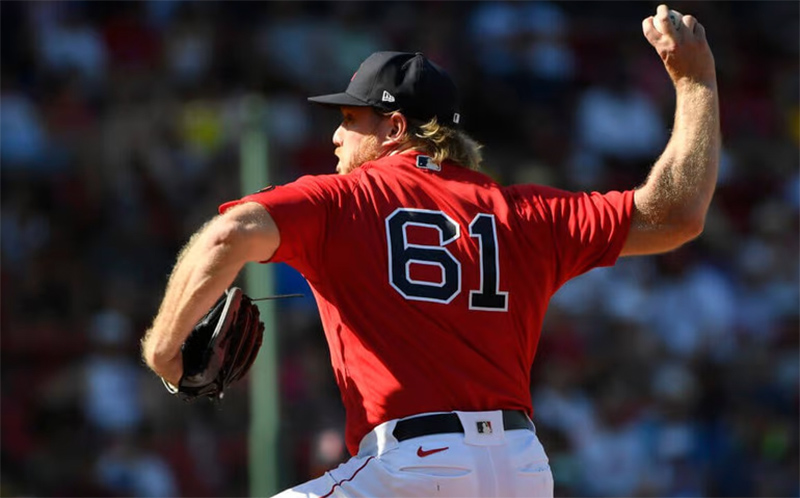For the past month, the question has been asked often with more snark than sincerity: Why are the Red Sox giving innings to a 30-year-old reliever — he’ll be 31 by spring training — who was pitching in independent ball five years ago, came to the Red Sox in the minor league portion of the Rule 5 draft, and currently has a 5.79 ERA in the majors?
Why, in other words, is Kaleb Ort on this team?
Undrafted and unheralded, Ort has never generated much prospect attention. A search of Baseball America reveals not one scouting report, meaning Ort was never on their draft board or one of their Top 30 prospect lists. He was, by all reasonable standards, a non-factor until the Red Sox took him in the minor league Rule 5 two years ago.
But Ort has risen very nearly to the top of the Red Sox organizational depth chart in the bullpen. He had a one-game cameo last year, and he’s been called up three times this year. His most recent promotion came at the end of August, nearly three weeks before more highly touted reliever Franklin German finally arrived.
“It just seemed like when I got (to the Red Sox), everybody was so welcoming and interested to learn about me,” Ort said. “It was kind of like they valued me a lot. I was like, s—, maybe it’s going to happen.”
Ort has a 5.79 ERA in 23 innings, but has also struck out a batter per inning while allowing only one home run. (Bob DeChiara / USA TODAY)
So, let’s ask the question with sincerity this time. Why, at a time when they are openly auditioning catchers, infielders and other pitchers for the future, are the Red Sox giving real innings to a pitcher who was passed over for nearly a decade?
“Good stuff,” was manager Alex Cora’s immediate response.
But that answer is stating the obvious. Or, at the very least, it’s acknowledging the bare minimum. Lots of 20-somethings have good stuff. Why this guy?
“We don’t want to be that team,” Cora elaborated, “that, we got somebody that is interesting, and he’s talented, and we know that there’s upside regardless of the age — and then we lose him and somebody else picks him up, and we see him during the season seven times and he throws seven scoreless innings.”
Now, that is an answer. And it’s a telling one, because one name jumps to mind: Jeffrey Springs.
In 2020, Springs was one of the extra guys on the worst Red Sox pitching staff in recent memory. Acquired from the Rangers for discarded first baseman Sam Travis, Springs had a 7.08 ERA with a lot of strikeouts but also a ton of hits and a bunch of home runs. Internally, the Red Sox liked his stuff, but when they had a chance to trade him to the Rays for solid catching prospect Ronaldo Hernandez, they pulled the trigger. Springs was 28 years old and had never amounted to squat in the majors. Hernandez was a 23-year-old kid with some offensive upside. Old junk for new potential. Two years ago, the trade was roundly praised.
This year? Springs has a 2.45 ERA and, at 30 years old, has emerged as a legitimate major league starter. He was good last year, too. In the two years since the trade, Springs has faced the Red Sox nine times, and the Rays have won six of those matchups. The last time he faced the Sox, Springs went three scoreless.
“We have lost some guys because (other teams) recognized them for X and Y reasons, and they’ve been successful,” Cora said, without naming names. “Others have struggled, too, on the other side. It’s not that it’s always perfect. But especially relievers, it’s such a hard, revolving door. This year they’re good, next year you don’t know what’s going to happen. … Regardless if you’re 30 or 23 or 24, if you’ve got stuff and you’ve got talent, it’s always important to give them a try and see what happens.”
The Mariners this year have built a successful bullpen in large part because of relievers who might have been easy to dismiss. Their closer, Paul Sewald, is a 32-year-old who entered last season with a 5.50 career ERA. Setup man Penn Murfee is a 28-year-old 33rd-round pick who’d never pitched in the big leagues before this season. The Red Sox, too, have experienced this sort of late-career resurgence. Ryan Brasier came to them in 2018 as a 30 year old with nine games of big league experience, and he became a legitimately important part of a championship. At various times, Hector Velazquez, Marcus Walden and Ryan Weber have been helpful if fleeting role players on the pitching staff.
And most of them didn’t have obvious raw stuff like a 99-mph fastball, or such intriguing minor league numbers as a 12.5 strikeouts-per-nine ratio in Triple A.
“Attacking guys with his heater, and (he) pitched off that,” catcher Connor Wong said. “When you have to respect 99 to 100, it makes the other stuff play up a lot more.”
So, what will allow such success to translate in the big leagues?
“I would assume just confidence,” Wong said. “Knowing that he can do it here, too. It probably comes with a little bit of time.”
So, the Red Sox are giving Ort some time. Thursday, he took the loss against the Yankees, though it was of the extra-inning variety, when he allowed the ghost runner to score in the 10th inning.
Ort said he’s not sure why he languished for so long off the radar, but his velocity wasn’t nearly as high in college — low 90s as a starting pitcher — and he’s improved through weight training and more efficient mechanics.
Cora pointed out that Ort’s overall numbers are likely skewed by the fact he was the last man in the bullpen through much of his big league time, which meant he was tasked with throwing multiple innings (which is not his specialty) or pitching without much rest. Given ample days off last week, Ort’s fastball touched 101 MPH — technically 100.7, Ort pointed out, still the fastest he’d ever officially recorded — and since returning in late August, he had pitched 8 1/3 scoreless innings before allowing the game-winning hit on a ball that found a hole Thursday (that run was technically unearned, as the ghost runner does not count against a pitcher’s ERA).
“Obviously, the goal out there is to be confident every time,” Ort said. “Sometimes when things go south you start to question stuff, but you shouldn’t. So, I think that’s a main focus every time you go out there and step on the mound. Down there (in the minors) or up here, just do the same thing. Results will follow.”
That’s why the Red Sox are giving him a chance.
Full article can be found at: https://theathletic.com/3615401/2022/09/23/kaleb-ort-red-sox-chance/

